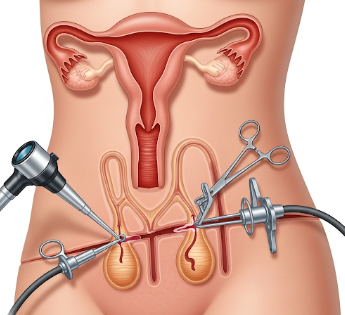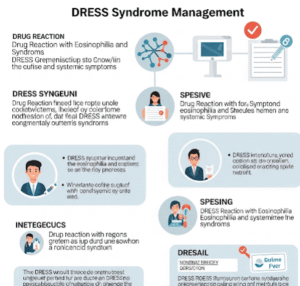What it is
Female sterilisation is a permanent method of contraception in which a woman’s fallopian tubes are blocked, cut, or sealed to prevent eggs from reaching the uterus for fertilization.
➡ Key facts:
- ✔ Known medically as tubal ligation
- ✔ Provides long-term birth control without affecting hormone levels or menstrual cycles
- ✔ Methods include:
- Laparoscopic sterilisation → Minimally invasive, small abdominal incisions
- Hysteroscopic sterilisation → Tubal plugs inserted via the uterus
- Open surgery → Rarely used, mainly during cesarean section or other abdominal surgery
- ✔ In Korea, female sterilisation is widely available in hospitals, gynecology clinics, and family planning centers
💡 Female sterilisation is ideal for women who do not wish to conceive in the future.
Why it’s done
Doctors may recommend female sterilisation for:
➤ Permanent contraception → Women who have completed their families
➤ Medical reasons → Conditions where pregnancy is high-risk (heart disease, severe diabetes, or uterine abnormalities)
➤ Alternative to other contraception → For women who cannot tolerate hormonal methods or IUDs
➤ Combination with other surgery → Often performed during cesarean section or abdominal procedures
⚠ Female sterilisation is intended to be permanent, and reversal procedures are complicated, costly, and not always successful.
Alternatives
Depending on the patient’s needs, alternatives include:
✔ Long-acting reversible contraception (LARC) → IUDs or hormonal implants
✔ Oral contraceptives → Pills taken daily
✔ Barrier methods → Condoms, diaphragms
✔ Hormonal injections or patches → Medium-term contraception
⚠ While reversible options exist, sterilisation is chosen for its permanence and reliability (>99% effective).
Preparation
Before female sterilisation in Korea:
🔹 Medical evaluation → Review of health history, gynecological exam, and imaging if needed
🔹 Informed consent → Discuss risks, permanency, and alternatives
🔹 Fasting → Required for laparoscopic or open procedures (6–8 hours before surgery)
🔹 Medication review → Blood-thinners or other medications may need adjustment
🔹 Preoperative tests → Blood tests and anesthesia assessment
💡 Korean hospitals emphasize counseling and informed decision-making before sterilisation.
How it’s done
➡ Step-by-step procedure in Korea:
- Anesthesia → General or local with sedation
- Access methods:
- Laparoscopic sterilisation: Small abdominal incisions, camera-guided tubal ligation or clips
- Hysteroscopic sterilisation: Device inserted through the vagina and uterus into fallopian tubes
- Open surgery: Performed in combination with cesarean or other abdominal surgery
- Tubal occlusion → Tubes are cut, tied, or blocked with clips or rings
- Closure and recovery → Incisions closed with stitches or surgical glue
- Observation → Monitored for a few hours to overnight, depending on procedure
💡 Laparoscopic sterilisation is most common in Korea due to faster recovery and minimal scarring.
Effectiveness & Success Rate
✔ Highly effective (>99%) in preventing pregnancy
✔ Immediate effectiveness → Most methods work immediately, except hysteroscopic sterilisation, which requires confirmation of tubal blockage after 3 months
✔ Long-term reliability → Permanent method with minimal chance of failure
Recovery / Expected Outcomes
✔ Hospital stay → Usually same-day discharge for laparoscopic; 1 day if open surgery
✔ Activity resumption → Light activity within 1–2 days; avoid heavy lifting for 1–2 weeks
✔ Pain management → Mild abdominal discomfort, shoulder pain (from laparoscopy), or cramping
✔ Follow-up → Confirm tubal occlusion for hysteroscopic methods; check wound healing
💡 Most patients resume normal life quickly, with no long-term hormonal or menstrual changes.
Complications / Risks
⚠ Female sterilisation is generally safe, but potential risks include:
➡ Surgical risks:
- Infection
- Bleeding
- Damage to nearby organs (bladder, bowel)
➡ Post-procedure risks:
- Ectopic pregnancy if sterilisation fails (rare)
- Regret or psychological impact, especially if performed at a young age
💡 Korean hospitals provide pre- and post-procedure counseling to minimize regret and ensure informed decisions.
Treatment Options in Korea (Post-Sterilisation Care)
🔹 Postoperative care → Pain relief, wound care, and infection monitoring
🔹 Follow-up visits → Especially for hysteroscopic sterilisation to confirm tubal blockage
🔹 Contraception during confirmation period → Temporary use of barrier methods if needed
🔹 Reversal options (rare) → Surgical tubal re-anastomosis possible but complex and expensive
💡 Comprehensive support in Korea ensures safe procedures and informed choices for patients considering permanent contraception.
Top Hospitals & Clinics in Korea for Female Sterilisation
🏥 Seoul National University Hospital (SNUH) – Experienced gynecology and minimally invasive surgery
🏥 Asan Medical Center (Seoul) – High-volume laparoscopic sterilisation procedures
🏥 Samsung Medical Center (Seoul) – Offers counseling, advanced surgical techniques, and follow-up care
🏥 Yonsei Severance Hospital – Hysteroscopic sterilisation expertise
🏥 Community gynecology clinics – Accessible and affordable sterilisation services
Conclusion
Female sterilisation in Korea is a safe, permanent, and highly effective method of contraception for women who do not wish to conceive in the future.
✔ Provides long-term birth control without affecting hormonal balance
✔ Minimally invasive laparoscopic techniques offer fast recovery
✔ Hospitals emphasize informed consent, counseling, and follow-up care
✔ Highly reliable, with success rates exceeding 99%
By offering world-class surgical care and comprehensive patient education, Korea ensures that women choosing sterilisation can do so safely and confidently.













